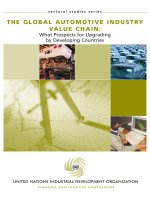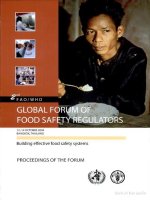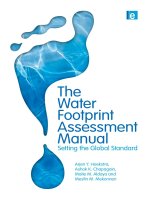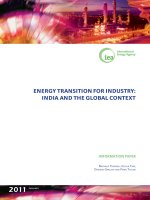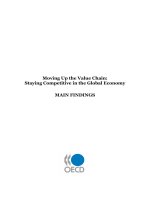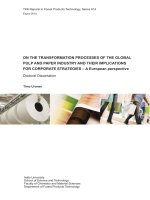The Water Footprint Assessment Manual Setting the Global Standard docx
Bạn đang xem bản rút gọn của tài liệu. Xem và tải ngay bản đầy đủ của tài liệu tại đây (3.16 MB, 228 trang )
The WaTer FooTprinT assessmenT manual
Hardback PPC: Live area – 159 x 240mm – Trim size – 156 x 234mm – Bleed – 18mm – Spine – 24.2mm
C-m-Y-K 1 page document
Cover image: ‘Water Background’ © istockphoto.com/Selahattin BAYRAM
Water / Environmental and Sustainability Assessment /
Agriculture and Food
Earthscan strives to minimize its impact on the environment
www.earthscan.co.uk
People use a lot of water for drinking, cooking and washing, but
significantly more for producing things such as food, paper and cotton
clothes. The water footprint is an indicator of water use that looks at both
direct and indirect water use of a consumer or producer. Indirect use refers
to the ‘virtual water’ embedded in tradable goods and commodities, such
as cereals, sugar or cotton. The water footprint of an individual, community
or business is defined as the total volume of fresh water that is used to
produce the goods and services consumed by the individual or community
or produced by the business.
This book offers a complete and up-to-date overview of the global standard
on water footprint assessment as developed by the Water Footprint Network.
More specifically it:
provides a comprehensive set of methods for water footprint assessment
shows how water footprints can be calculated for individual processes
and products, as well as for consumers, nations and businesses
contains detailed worked examples of how to calculate green, blue and
grey water footprints
describes how to assess the sustainability of the aggregated water
footprint within a river basin or the water footprint of a specific product
includes an extensive library of possible measures that can contribute to
water footprint reduction.
Arjen Y. Hoekstra is Professor in Water Management at the University of Twente, the
Netherlands; creator of the water footprint concept and Scientific Director of the Water
Footprint Network.
Ashok K. Chapagain was an irrigation engineer in Nepal for more than a decade, has
worked as a researcher at the University of Twente and currently works for the WWF in the UK.
Maite M. Aldaya works as a consultant for the United Nations Environment Programme
(UNEP) and is a researcher at the Water Footprint Network.
Mesfin M. Mekonnen was an energy expert at the Ministry of Mines and Energy in Ethiopia,
and is currently a PhD student at the University of Twente.
The
Water
Footprint
Assessment
Manual
Setting the Global Standard
The Water Footprint Assessment Manual
Arjen Y. Hoekstra,
Ashok K. Chapagain,
Maite M. Aldaya and
Mesfin M. Mekonnen
Hoekstra, Chapagain, Aldaya and Mekonnen
e Water Footprint Assessment Manual
e Water Footprint Assessment Manual
Setting the Global Standard
Arjen Y. Hoekstra, Ashok K. Chapagain,
Maite M. Aldaya and Mesn M. Mekonnen
London • Washington, DC
pu bli shi ng for a sus tai nable futu re
First published in 2011 by Earthscan
Copyright © Water Footprint Network 2011
All rights reserved. No part of this publication may be reproduced, stored in a retrieval system, or
transmitted, in any form or by any means, electronic, mechanical, photocopying, recording or otherwise,
except as expressly permitted by law, without the prior, written permission of the publisher.
Earthscan Ltd, Dunstan House, 14a St Cross Street, London EC1N 8XA, UK
Earthscan LLC,1616 P Street, NW, Washington, DC 20036, USA
Earthscan publishes in association with the International Institute for Environment and Development
For more information on Earthscan publications, see www.earthscan.co.uk or write to
ISBN: 978-1-84971-279-8 hardback
Typeset by JS Typesetting Ltd, Porthcawl, Mid Glamorgan
Cover design by Rob Watts; water footprint design by Angela Morelli
A catalogue record for this book is available from the British Library
Library of Congress Cataloging-in-Publication Data
e water footprint assessment manual : setting the global standard / Arjen Y. Hoekstra [et al.].
p. cm.
Includes bibliographical references and index.
ISBN 978-1-84971-279-8 (hardback)
1. Water consumption–Measurement. 2. Water consumption–Environmental aspects. 3. Water-
supply–Accounting. I. Hoekstra, Arjen Y., 1967–
TD499.W384 2011
333.91’13–dc22
2010047901
At Earthscan we strive to minimize our environmental impacts and carbon footprint through reducing
waste, recycling and osetting our CO
2
emissions, including those created through publication of this
book. For more details of our environmental policy, see www.earthscan.co.uk.
Printed and bound in the UK by TJ International Ltd, Padstow, Cornwall.
e paper used is FSC certied and the ink are vegetable based.
Contents
List of Figures, Tables and Boxes ix
Acknowledgements xiii
Preface xvii
Acronyms xix
1 Introduction 1
1.1 Background 1
1.2 e water footprint concept 2
1.3 Water footprint assessment 3
1.4 Guide for the reader 5
2 Goals and Scope of Water Footprint Assessment 7
2.1 Goals of water footprint assessment 7
2.2 Scope of water footprint accounting 9
2.3 Scope of water footprint sustainability assessment 15
2.4 Scope of water footprint response formulation 16
3 Water Footprint Accounting 19
3.1 Human appropriation of fresh water: What do we measure
and why? 19
3.2 Coherence between dierent sorts of water footprint accounts 21
3.3 Water footprint of a process step 23
3.3.1 Blue water footprint 23
3.3.2 Green water footprint 29
3.3.3 Grey water footprint 30
3.3.4 Calculation of the green, blue and grey water footprint
of growing a crop or tree 40
3.4 Water footprint of a product 46
3.4.1 Denition 46
3.4.2 Schematization of the production system into process steps 47
3.4.3 Calculation of a product water footprint 48
3.5 Water footprint of a consumer or group of consumers 52
vi e Water Footprint Assessment Manual
3.5.1 Denition 52
3.5.2 Calculation 52
3.6 Water footprint within a geographically delineated area 53
3.6.1 Denition 53
3.6.2 Calculation 53
3.7 National water footprint accounting 54
3.7.1 e national water footprint accounting scheme 54
3.7.2 Calculation of the water footprint within a nation 55
3.7.3 Calculation of the water footprint of national consumption 56
3.7.4 Water savings related to trade 60
3.7.5 National water dependency versus water self-suciency 61
3.8 Water footprint accounting for catchments and river basins 61
3.9 Water footprint accounting for municipalities, provinces or other
administrative units 63
3.10 Water footprint of a business 63
3.10.1 Denition 63
3.10.2 Choosing the organizational boundaries of the business 65
3.10.3 Calculation of the business water footprint 68
4 Water Footprint Sustainability Assessment 73
4.1 Introduction 73
4.2 Geographic sustainability: Sustainability of the water footprint
within a catchment or river basin 76
4.2.1 Introduction 76
4.2.2 Environmental sustainability criteria for identifying
environmental hotspots 78
4.2.3 Social sustainability criteria for identifying social hotspots 87
4.2.4 Economic sustainability criteria for identifying economic
hotspots 88
4.2.5 Assessing primary and secondary impacts in the hotspots
identied 88
4.3 Sustainability of the water footprint of a process 89
4.4 Sustainability of the water footprint of a product 91
4.4.1 Identifying the unsustainable components in the water
footprint of a product 91
4.4.2 Water footprint impact indices reecting local
environmental impacts 94
4.5 Sustainability of the water footprint of a business 97
4.6 Sustainability of the water footprint of a consumer 97
Contents vii
5 Library of Water Footprint Response Options 99
5.1 Shared responsibility 99
5.2 Reducing the water footprint of humanity: What is possible? 99
5.3 Consumers 103
5.4 Companies 106
5.5 Farmers 107
5.6 Investors 109
5.7 Governments 110
6 Limitations 115
7 Future Challenges 119
7.1 Water footprint assessment methodology and data 119
7.2 Application of the water footprint in dierent contexts 122
7.3 Embedding the water footprint in existing water and
environmental accounts and reports 123
7.4 Linking to ecological, energy and carbon footprint methods 124
7.5 Linking to material ow analysis, input-output modelling and life
cycle assessment 125
8 Conclusion 129
Appendix I Calculation of Green and Blue Evapotranspiration Using the
CROPWAT Model 131
Appendix II Calculating the Process Water Footprint of Growing a Crop:
An Example for Sugar Beet in Valladolid (Spain) 135
Appendix III Calculating the Water Footprint of a Product: Example for
Rened Sugar from Valladolid (Spain) 143
Appendix IV Examples of Grey Water Footprint Calculations 147
Appendix V Environmental Flow Requirements 151
Appendix VI Frequently Asked Questions 155
References 169
List of Symbols 183
Glossary 187
Index 199
List of Figures, Tables and Boxes
Figures
1.1 Schematic representation of the components of a water footprint.
It shows that the non-consumptive part of water withdrawals
(the return ow) is not part of the water footprint. It also shows that,
contrary to the measure of ‘water withdrawal’, the ‘water footprint’
includes green and grey water and the indirect water-use component 3
1.2 Four distinct phases in water footprint assessment 4
3.1 e green and blue water footprint in relation to the water balance
of a catchment area 20
3.2 Process water footprints as the basic building block for all other water
footprints 22
3.3 e direct and indirect water footprint in each stage of the supply
chain of an animal product 24
3.4 e relation between the water footprint of national consumption
and the water footprint within a nation in a simplied example for
two trading nations 24
3.5 Blue water footprint accounting in the case of water recycling and
reuse 28
3.6 e subsequent processes in irrigation: storing water, transport of
water, irrigation on the eld. Each process step has its own water
footprint 43
3.7 Schematization of the production system to produce product p into
k process steps. Some steps are in series, others are parallel. e water
footprint of output product p is calculated as the sum of the process
water footprints of the processes that constitute the production system.
Note: this simplied scheme presupposes that p is the only output
product following from the production system 48
3.8 Schematization of the last process step in the production system to
produce product p. e water footprint of output product p is
calculated based on the water footprints of the input products and the
process water footprint when processing the inputs into the outputs 49
x e Water Footprint Assessment Manual
3.9 e national water footprint accounting scheme. e accounting
scheme shows the various balances that hold for the water footprint
related to national consumption (WF
cons,nat
), the water footprint
within the area of the nation (WF
area,nat
), the total virtual-water
export (V
e
) and the total virtual-water import (V
i
) 56
3.10 e catchment water footprint accounting scheme. e accounting
scheme shows the various balances that hold for the water footprint
of consumers living within the catchment, the water footprint
within the catchment area, the total virtual-water export from the
catchment and the total virtual-water import into the catchment 62
3.11 Composition of the water footprint of a business 64
3.12 Business that consists of three business units producing products
A–C. Product inow I
u
[x,i] refers to the annual volume of input
product i from source x into business unit u. Product outow P
u
[p]
refers to the annual volume of output product p from business unit
u. Product ow P
*
u
[p] refers to the part of P
u
[p] that goes to another
business unit within the same business 68
4.1 Assessment of the sustainability of the water footprint within a
catchment or river basin in four steps 76
4.2 e blue water footprint over a year compared to the blue water
availability, where the latter is equal to run-o (under undeveloped
conditions) minus environmental ow requirements 83
II.1 Climate station in Valladolid (Spain) (dot in black) and sugar beet
harvested area in Spain (unit: proportion of grid cell area) 136
III.1 Spanish rened sugar production (from sugar beet) diagram
including product fractions 144
Tables
2.1 Spatiotemporal explication in water footprint accounting 12
3.1 Examples of the components of a business water footprint 64
4.1 Example of how to assess the extent to which the water footprint
of a product is sustainable, based on two criteria: geographic
sustainability of the water footprints in the catchments in which the
process steps are located and sustainability of the underlying process
steps themselves. Priority components in the water footprint of a
product can be identied based on which components are
unsustainable and the share of a component in the total water
footprint of the product. e table needs to be lled separately for
the green, blue and grey water footprint of the product 93
List of Figures, Tables and Boxes xi
5.1 Possible water footprint reduction targets per sector and water
footprint component 101
5.2 Priorities in water footprint reduction 103
5.3 Corporate water footprint response options 108
5.4 Options for crop farmers to reduce their water footprint 109
5.5 Options for governments to reduce water footprints and mitigate
related impacts 111
7.1 An overview of water footprint studies 122
7.2 How water footprint assessments can feed LCA 126
II.1 Planting and harvesting dates and yield for sugar beet production
in Valladolid (Spain) 136
II.2 Total green-blue water evapotranspiration based on the CWR
output table of CROPWAT 8.0 137
II.3 Irrigation schedule under the rain-fed scenario: Output table of
CROPWAT 8.0 139
II.4 Irrigation schedule under the irrigation scenario: Output table of
CROPWAT 8.0 140
II.5 Calculation of the green and blue components of the process water
footprint (m
3
/ton) for sugar beet in Valladolid (Spain) using the
CWR-option and irrigation schedule option for a medium soil 141
II.6 Calculation of the grey component of the process water footprint
(m
3
/ton) for sugar beet in Valladolid (Spain) 142
III.1 Green, blue and grey water footprint for sugar beet in Valladolid
(Spain) (m
3
/ton) 146
Boxes
2.1 Goals of water footprint assessment 8
2.2 Are there ‘scopes’ in water footprint accounting as there are in the
case of corporate carbon footprint accounting? 14
3.1 e relation between the dierent sorts of water footprints 23
3.2 Unit of a water footprint 25
3.3 Data sources for the calculation of a blue water footprint 27
3.4 e history of the grey water footprint concept 31
3.5 e concept of critical load 34
3.6 e grey water footprint in dierent cases of point-source pollution 36
3.7 ree-tier approach in estimating diuse pollution loads 38
3.8 Data sources for the calculation of the water footprint of ‘growing
a crop’ 44
xii e Water Footprint Assessment Manual
3.9 Terminology: Water footprint, virtual-water content, embedded
water 46
3.10 What is new for companies when considering their business water
footprint? 66
4.1 History of water footprint sustainability assessment 74
4.2 Sustainability criteria for water use and allocation within a
catchment or river basin 77
4.3 Environmental green water requirement 81
4.4 e eect of the green water footprint on blue water availability 82
4.5 e sustainability of a blue water footprint depends on how it
aects both blue-water ows and stocks 84
4.6 How the ‘blue water scarcity’ as dened in water footprint studies
diers from conventional water scarcity indicators 86
5.1 Water neutrality 104
5.2 Water footprint osetting 105
Acknowledgements
is manual has been written with the great help of many organizations and
individuals. First of all we would like to thank all partners of the Water Footprint
Network that have contributed in so many dierent ways to the maturing of the
water footprint concept. We thank the following 130 organizations, all partners of
the network (as per 16 October 2010): ADAS (UK), Adecagua (Spain), Allenare
Consultores (Mexico), Alliance for Water Stewardship (US/Australia), AmBev
– Companhia de Bebidas das Americas (Brazil), APESA (France), Arup (UK),
Association du Flocon à la Vague (France), ATA – Ativos Técnicos e Ambientais
(Brazil), Austrian Institute of Technology (Austria), Barilla (Italy), Beijing
Forestry University (China), Bianconi Consulting (UK), Bionova (Finland),
Blonk Milieu Advies (Netherlands), C&A (Germany), CEIGRAM – Research
Centre for the Management of Agricultural and Environmental Risks, Technical
University of Madrid (Spain), CESTRAS – Centro de Estudos e Estratégias para
a Sustentabilidade (Portugal), Climate Change Commission (Philippines), Coca-
Cola Hellenic (Greece), Confederation of European Paper Industries (Belgium),
Consejo Consultivo del Agua (Mexico), Conservation International (US),
CREM (Netherlands), CSE Centre for Sustainability and Excellence (Greece),
CSQA Certicazioni (Italy), Cyprus University of Technology (Cyprus), Decide
Soluciones Estratégicas (Mexico), Denkstatt (Austria), DHV (Netherlands),
Directorate-General for Water Aairs (Netherlands), Dole Food Company
(US), Eawag – Swiss Federal Institute of Aquatic Science and Technology
(Switzerland), Ecolife (Belgium), Ecologic – Institute for International and
European Environmental Policy (Germany), Ecological Society for Eastern
Africa (Kenya), Ecometrica (UK), EcosSistemas Sustainable Solutions (Brazil),
EMWIS – Euro-Mediterranean Information System on know-how in the
Water sector (France), Enzen Water (UK), EPAL – Empresa Portuguesa de
Aguas Livres (Portugal), Fibria Celulose (Brazil), First Climate (Germany),
FloraHolland (Netherlands), Food and Drink Federation (UK), Fundación
Centro de las Nuevas Tecnologías del Agua (CENTA) (Spain), Fundación
Chile (Chile), Geoklock – Consultoria e engenharia ambiental (Brazil), Global
Footprint Network (US), GRACE (US), Green Solutions (Chile), Grontmij
(Netherlands), Heineken (Netherlands), iMdea Water Foundation (Spain),
xiv e Water Footprint Assessment Manual
Institut für Nachhaltige Landbewirtschaftung (Germany), International
Finance Corporation (US), International Water Management Institute (Sri
Lanka), Jain Irrigation Systems (India), Jutexpo (UK), Kingston University
(UK), KWR – Watercycle Research Institute (Netherlands), Lafarge (France),
Leibniz Institute for Agricultural Engineering Potsdam-Bornim (Germany),
LimnoTech (US), Live Earth (US), Marcelino Botín Foundation – e Water
Observatory (Spain), Massey University – Soil and Earth Sciences Group (New
Zealand), McCain Alimentaire (France), Michigan Technological University
– Center for Water and Society (US), National Ground Water Association
(US), National University of Cordoba (Argentina), Natura Cosméticos (Brazil),
Nestlé (Switzerland), Netherlands Water Partnership (Netherlands), Next Planet
ASBL (Belgium), Oranjewoud (Netherlands), Pacic Institute for Studies in
Development, Environment, and Security (US), Partners for Innovation
(Netherlands), PE International (Germany), People 4 Earth (Netherlands),
PepsiCo (USA), Plant and Food Research (New Zealand), PRé Consultants
(Netherlands), PricewaterhouseCoopers, Province of Overijssel (Netherlands),
PTS – Papiertechnische Stiftung (Germany), Pyramid Sustainable Resource
Developers (Australia), Quantis (Switzerland), Química del Campo (Chile),
Raisio (Finland), Redevco (Netherlands), Renault (France), RodaxAgro
(Greece), Royal Haskoning (Netherlands), SABMiller (UK), Safe Drinking
Water Foundation (Canada), SERI – Sustainable Europe Research Institute
(Austria), Smart Approved WaterMark (Australia), Soil & More International
(Netherlands), Source 44 (US), Stora Enso (Sweden), Summa Environmental
Technologies (Ecuador), Swiss Development Agency (Switzerland), e Coca-
Cola Company (US), e Nature Conservancy (US), Tobco (Belgium), UNEP
(France), UNESCO-IHE Institute for Water Education (Netherlands), Unilever
(UK), University of Chile (Chile), University of Natural Resources and Applied
Life Sciences (Austria), University of São Paulo – Escola de Engenharia de
São Carlos (Brazil), University of São Paulo – GovÁgua (Brazil), University of
Siena (Italy), University of Tokyo (Japan), University of Twente (Netherlands),
University of Zaragoza (Spain), UPM-Kymmene Corporation (Finland),
URS Corporation (UK), USAID – United States Agency for International
Development (US), Vewin – the Dutch Association of Drinking Water
Companies (Netherlands), Viña Concha y Toro (Chile), Viña De Martino
(Chile), Viña Errazuriz (Chile), Water Neutral Foundation (South Africa), Water
Strategies (UK), Wildlife Trust (US), World Business Council for Sustainable
Development (Switzerland), WWF – the global conservation organization
(Switzerland) and Zero Emissions Technologies (Spain).
We thank the members of WFN’s grey water footprint working group,
which critically reviewed the grey water footprint concept and provided valuable
suggestions for improving the denition and guidelines: Jose Albiac (CITA,
Acknowledgements xv
Spain), Maite Aldaya (University of Twente, the Netherlands), Brent Clothier
(Plant and Food Research, New Zealand), James Dabrowski (CSIRO, South
Africa), Liese Dallbauman (Pepsi, UK), Axel Dourojeanni (Fundación Chile,
Chile), Piet Filet (WWF, Australia), Arjen Hoekstra (University of Twente,
the Netherlands), Mark Huijbregts (Radboud University, the Netherlands),
Marianela Jiménez (Nestlé, Switzerland), Greg Koch (e Coca Cola Company,
US), Marco Mensink (CEPI, Belgium), Angel de Miguel García (IMDEA Agua,
Spain), Jason Morrison (Pacic Institute, US), Juan Ramon Candia (Fundación
Chile, Chile), Todd Redder (Limnotech, US), Jens Rupp (Coke Hellenic,
Greece), Ranvir Singh (Massey University, New Zealand), Alistair Wyness (URS
Corporation, UK), Erika Zarate (WFN, the Netherlands), Matthias Zessner
(Vienna University of Technology, Austria) and Guoping Zhang (WFN, the
Netherlands).
A second working group of the Water Footprint Network critically reviewed
and proposed improvements to the method of water footprint sustainability
assessment. We are grateful to all its members: Maite Aldaya (University of
Twente, the Netherlands), Upali Amarasinghe (IWMI, Sri Lanka), Fatima
Bertran (Denkstatt, Austria), Sabrina Birner (IFC, US), Anne-Leonore Bo
(WBCSD, Switzerland), Emma Clarke (Pepsi, UK), Joe DePinto (Limnotech,
US), Roland Fehringer (Denkstatt, Austria), Carlo Galli (Nestlé, Switzerland),
Alberto Garrido (Technical University of Madrid, Spain), Arjen Hoekstra
(University of Twente, the Netherlands), Denise Knight (Coca-Cola, US),
Junguo Liu (Beijing Forestry University, China), Michael McClain (UNESCO-
IHE, Netherlands), Marco Mensink (CEPI, Belgium), Jay O’Keee (UNESCO-
IHE, Netherlands), Stuart Orr (WWF, Switzerland), Brian Richter (TNC, US),
Hong Yang (EAWAG, Switzerland) and Erika Zarate (WFN, Netherlands).
We also thank the members of the Scientic Peer Review Committee, who
reviewed the draft of this manual: Huub Savenije (Delft University of Tech-
nology, the Netherlands), Alberto Garrido (Technical University of Madrid,
Spain), Junguo Liu (Beijing Forestry University, China), Johan Rockström
(Stockholm University & Stockholm Environment Institute, Sweden), Pasquale
Steduto (FAO, Italy), and Mathis Wackernagel (Global Footprint Network,
US). In addition, we thank Brian Richter (TNC, US) for reviewing a draft of
the chapter on sustainability assessment.
ere have been many other valuable inputs. We cannot mention the
hundreds of individuals and organizations that have contributed by providing
feedbacks on the water footprint concept and application by means of email
and personal contact. We would like to mention, however, at least: the Food
and Agriculture Organization of the United Nations, in particular Giovanni
Muñoz, for valuable advice on the CROPWAT model; the World Bank
Institute, particularly Mei Xie, for cooperating in the development of various
xvi e Water Footprint Assessment Manual
water footprint training materials; the World Business Council for Sustainable
Development for organizing a valuable workshop on the water footprint in
Montreux, Switzerland, March 2010; the Beverage Industry Environmental
Roundtable (BIER) for looking into the specic implications of the water
footprint for the beverage sector; and Soil & More International for providing
extensive feedback on the inuence of soil management on the water footprint
of crop production.
We thank the employers of the authors for allowing them to dedicate time
to prepare and write the manual: University of Twente, employer of Arjen
Hoekstra and Mesn Mekonnen and former employer of Maite Aldaya; WWF-
UK, employer of Ashok Chapagain; the Research Centre for the Management of
Agricultural and Environmental Risks (CEIGRAM) of the Technical University
of Madrid, former employer of Maite Aldaya; and the United Nations
Environment Programme (UNEP), current employer of Maite Aldaya.
Finally, we thank the staff of the Water Footprint Network for their
continued dedication, their contributions to the advancement of water footprint
thinking, application and dissemination and for their friendship: Derk Kuiper,
Erika Zarate and Guoping Zhang. anks to Joshua Waweru and Joke Meijer-
Lentelink for their secretarial support and to René Buijsrogge for his help in
maintaining the water footprint website.
Preface
is book contains the global standard for ‘water footprint assessment’ as
developed and maintained by the Water Footprint Network (WFN). It covers a
comprehensive set of denitions and methods for water footprint accounting. It
shows how water footprints are calculated for individual processes and products,
as well as for consumers, nations and businesses. It also includes methods
for water footprint sustainability assessment and a library of water footprint
response options.
A shared standard on denitions and calculation methods is crucial given the
rapidly growing interest in companies and governments to use water footprint
accounts as a basis for formulating sustainable water strategies and policies.
is manual has been prepared by the authors as requested by the WFN. e
current manual is an updated, revised and expanded version of Water Footprint
Manual: State of the Art 2009, published by the WFN in November 2009
(Hoekstra et al, 2009a). is new edition has been produced after intensive
consultations with partners and researchers worldwide. Directly following
the publication of the Water Footprint Manual, all partners of the WFN were
invited to provide feedback on the manual. In addition, two working groups
were formed, consisting of individuals from partners of the WFN and invited
experts. One working group addressed questions around the grey water footprint
(Zarate, 2010a); the other one studied issues pertaining to water footprint
sustainability assessment (Zarate, 2010b). In addition, a number of partners
initiated pilot projects in collaboration with the WFN that aimed at exploring
the practical implications of using the water footprint in formulating a corporate
water strategy or water policy in a specic geographical setting. On the basis of
feedbacks received – new scientic publications, experiences from practical water
footprint pilots and working group reports – the WFN prepared a draft of this
edition. e Scientic Peer Review Committee of the Water Footprint Network
reviewed the draft version of this edition and made specic recommendations
with respect to revisions of the draft. e manual as it lies here is the result of
incorporating the recommendations.
Also this edition will require revision in due time. All over the world research
in this area is rapidly developing and more and more pilot studies on water
xviii e Water Footprint Assessment Manual
footprint assessment are initiated, across all sectors of economy and covering all
continents. In order to learn from the various ongoing practical water footprint
pilot projects and from expected new scientic publications, the WFN invites
both partners and non-partners to provide feedback on this edition of the
manual. In this way we hope to make best use of the diverse experiences that
individuals and organizations have when evaluating water footprints within
dierent contexts and for dierent purposes. We aim to further rene the water
footprint methodology so that it best serves the various purposes that dierent
sectors in society see for it, at the same time striving for coherence, consistency
and scientic scrutiny.
Joop de Schutter
Chair of the Supervisory Council of
the Water Footprint Network
Acronyms
CBD Convention on Biological Diversity
CWR crop water requirements
EPA Environmental Protection Agency
FAO Food and Agriculture Organization (UN)
GHG greenhouse gas
GIEWS Global Information and Early Warning System
GIS geographic information system
GMIA Global Map of Irrigation Areas
IPCC Intergovernmental Panel on Climate Change
IRBM integrated river basin management
IWRM integrated water resource management
LCA life cycle assessment
MFA material ow analysis
MPA maximum permissible addition
MPC maximum permissible concentration
TMDL total maximum daily load
UNCTAD United Nations Conference on Trade and Development
UNDP United Nations Development Programme
UNEP United Nations Environment Programme
WCED World Commission on Environment and Development
WFN Water Footprint Network
Chapter 1
Introduction
1.1 Background
Human activities consume and pollute a lot of water. At a global scale, most of
the water use occurs in agricultural production, but there are also substantial
water volumes consumed and polluted in the industrial and domestic sectors
(WWAP, 2009). Water consumption and pollution can be associated with
specic activities, such as irrigation, bathing, washing, cleaning, cooling and
processing. Total water consumption and pollution are generally regarded
as the sum of a multitude of independent water demanding and polluting
activities. ere has been little attention paid to the fact that, in the end, total
water consumption and pollution relate to what and how much communities
consume and to the structure of the global economy that supplies the various
consumer goods and services. Until the recent past, there have been few thoughts
in the science and practice of water management about water consumption
and pollution along whole production and supply chains. As a result, there is
little awareness regarding the fact that the organization and characteristics of a
production and supply chain strongly inuence the volumes (and temporal and
spatial distribution) of water consumption and pollution that can be associated
with a nal consumer product. Hoekstra and Chapagain (2008) have shown
that visualizing the hidden water use behind products can help in understanding
the global character of fresh water and in quantifying the eects of consumption
and trade on water resources use. e improved understanding can form a basis
for a better management of the globe’s freshwater resources.
Freshwater is increasingly becoming a global resource, driven by growing
international trade in water-intensive commodities. Apart from regional markets,
there are also global markets for water-intensive goods such as crop and livestock
products, natural bres and bio-energy. As a result, use of water resources has
become spatially disconnected from the consumers. is can be illustrated for
the case of cotton. From eld to end product, cotton passes through a number
of distinct production stages with dierent impacts on water resources. ese
2 e Water Footprint Assessment Manual
stages of production are often located in dierent places and nal consumption
can be in yet another place. For example, Malaysia does not grow cotton, but
imports raw cotton from China, India and Pakistan for processing in the textile
industry and exports cotton clothes to the European market (Chapagain et al,
2006b). As a result, the impacts of consumption of a nal cotton product on
the globe’s water resources can only be found by looking at the supply chain
and tracing the origins of the product. Uncovering the hidden link between
consumption and water use can form the basis for the formulation of new
strategies of water governance, because new triggers for change can be identied.
Where nal consumers, retailers, food industries and traders in water-intensive
products have traditionally been out of the scope of those who studied or were
responsible for good water governance, these players enter the picture now as
potential ‘change agents’. ey can be addressed now not only in their role as
direct water users, but also in their role as indirect water users.
1.2 The water footprint concept
e idea of considering water use along supply chains has gained interest after
the introduction of the ‘water footprint’ concept by Hoekstra in 2002 (Hoekstra,
2003). e water footprint is an indicator of freshwater use that looks not only
at direct water use of a consumer or producer, but also at the indirect water use.
e water footprint can be regarded as a comprehensive indicator of freshwater
resources appropriation, next to the traditional and restricted measure of water
withdrawal. e water footprint of a product is the volume of freshwater used to
produce the product, measured over the full supply chain. It is a multidimensional
indicator, showing water consumption volumes by source and polluted volumes
by type of pollution; all components of a total water footprint are specied
geographically and temporally. e blue water footprint refers to consumption
of blue water resources (surface and groundwater) along the supply chain of a
product. ‘Consumption’ refers to loss of water from the available ground-surface
water body in a catchment area. Losses occur when water evaporates, returns to
another catchment area or the sea or is incorporated into a product. e green
water footprint refers to consumption of green water resources (rainwater insofar
as it does not become run-o). e grey water footprint refers to pollution and
is dened as the volume of freshwater that is required to assimilate the load of
pollutants given natural background concentrations and existing ambient water
quality standards.
As an indicator of ‘water use’, the water footprint diers from the classical
measure of ‘water withdrawal’ in three respects (Figure 1.1):
Introduction 3
1. It does not include blue water use insofar as this water is returned to where
it came from.
2. It is not restricted to blue water use, but also includes green and grey water.
3. It is not restricted to direct water use, but also includes indirect water use.
e water footprint thus oers a better and wider perspective on how a consumer
or producer relates to the use of freshwater systems. It is a volumetric measure
of water consumption and pollution. It is not a measure of the severity of the
local environmental impact of water consumption and pollution. e local
environmental impact of a certain amount of water consumption and pollution
depends on the vulnerability of the local water system and the number of water
consumers and polluters that make use of the same system. Water footprint
accounts give spatiotemporally explicit information regarding how water is
appropriated for various human purposes. ey can feed the discussion about
sustainable and equitable water use and allocation and also form a good basis for
a local assessment of environmental, social and economic impacts.
1.3 Water footprint assessment
‘Water footprint assessment’ refers to the full range of activities to: (i) quantify
and locate the water footprint of a process, product, producer or consumer or
Figure1.1 Schematic representation of the components of a water footprint.
It shows that the non-consumptive part of water withdrawals (the return ow)
is not part of the water footprint. It also shows that, contrary to the measure
of ‘water withdrawal’, the ‘water footprint’ includes green and grey water and
the indirect water-use component
Water footprint of a consumer or producer
Indirect water use
Direct water use
Water
consumption
Green water footprint
Blue water footprint
Water
pollution
Grey water footprint
Green water footprint
Blue water footprint
Grey water footprint
Non-consumptive
water use (return flow)
Water withdrawal

